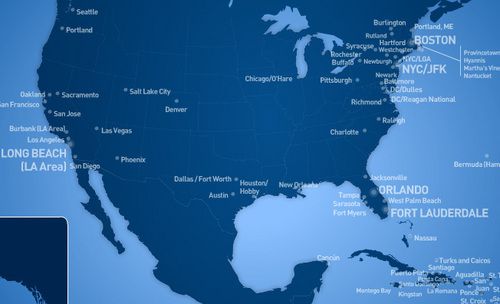The Metropolitan Airports Commission announced today it will reveal the identity on Wednesday of a new airline that will begin flying into the Minneapolis St. Paul International Airport. Let the speculation begin!
Minneapolis St. Paul Business Journal says MAC’s executive director told it last month that MAC was talking to “a few airlines,” including low-cost carriers JetBlue and Spirit.
Let’s guess!
Of the top 15 domestic airlines, only two don’t fly to MSP: JetBlue and Spirit, so the chances are pretty good it’s one of those airlines.
I’m going with Spirit. Check the current route map:
Spirit already has a couple of locations in the Central U.S. and adding Minneapolis St. Paul fills a little bit of a hole in the map. Plus, it flies places… places that are warm, places that are traditionally desired destinations of Minnesotans, including Las Vegas, which might be the most popular destination of Minnesotans.
Moreover, Spirit is all about cheap, especially with its $9 Fare Club. Presently, Minneapolis St. Paul is all about expensive. With very little competition — MSP never experienced the much-touted Southwest Effect — the airport has the 11th highest airline fares in the country.
If you’re an airline looking to take advantage of the entire reason for your existence, Minneapolis St. Paul would be a fine choice. The airline also recently added a crew base in Las Vegas, giving every indication it wants to expand its presence there. A good way to do that is to fly to cities where people want to fly to Vegas.
In the past, however, airlines that have tried to take on Delta’s former airline — Northwest — on the Las Vegas-to-MSP routes have paid a stiff price for doing so.
What about JetBlue? It’s the larger airline and it, too, has made a name for itself with cheap fares. So all of the reasons Spirit would want to fly here are also all of the reasons why JetBlue would find Minneapolis St. Paul attractive too.
But there’s something about the route map that suggests a reluctance to do so:
JetBlue doesn’t fly to Atlanta. It also doesn’t fly to Detroit or Memphis. Does that indicate a reluctance to go head-to-head with Delta in Delta hubs, of which Minneapolis St. Paul is one?
JetBlue also seems to have a strategy that tends to its bread-and-butter: the East Coast. The airline, based at JFK in New York, is doubling the number of flights at LaGuardia and Reagan after Delta and US Airways swapped landing slots. It’s also doing some expansion along the West Coast, but has always seemed to view the Midwest primarily as “flyover country.”
JetBlue only has two “hubs”: Boston and JFK. Adding Midwest flights doesn’t make a great deal of sense unless it opens a hub closer to the Midwest. Spirit Airlines has hubs in Detroit and Fort Lauderdale. Theoretically, a short hop to Detroit for connections makes more sense for MSP travelers.
If it’s either one of the airlines, expect slim pickings for non-stop service. Southwest started at MSP flying only to Chicago and has expanded it only gradually. Neither Spirit nor JetBlue have the capacity to offer very many non-stop destination, especially since doing so would invite an all-out war with Delta.
Passengers should also expect to pay fees. While the fares are cheap, Spirit in particular has a reputation for nickel-and-diming passengers. Check out this column a week or so ago from the Motley Fool:
I think no one was able to capture this better than CBS news and NPR personality Mo Rocca. Here’s what he had to tweet about his Spirit experience: “I’m really not an airline snob but boarding Spirit Air flight to Detroit & it feels like I’m trying get last helicopter out of Saigon #chaos.” The company’s growth plan is just getting started, so it might take a while for the word to spread about what flying Spirit really means.
In the second outcome, I see passengers embracing Spirit’s low costs, but figuring out ways to avoid the extra fees–by printing boarding passes at home, packing extra-light, and forgoing that $3 glass of water. You might think Spirit wouldn’t mind passengers doing this, but in the most recent quarter, these “non-ticket” sources of revenue accounted for a whopping 38.2% of revenue. Without that revenue, the airline would have most certainly not been profitable.
Spirit also charges for carry-on baggage. JetBlue, meanwhile, has just increased its fee for a second checked bag ($40), although it has a first-bag-free policy.
This is probably why the early cheering in the “guess the airline” game is for JetBlue. But this is Minnesota; We don’t get that lucky in these things.


